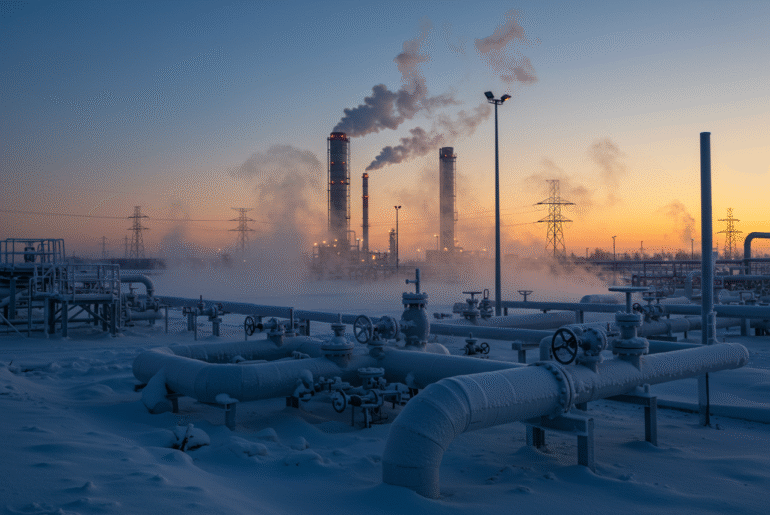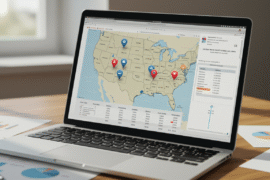This article may contain references to products or services from one or more of our advertisers or partners. We may receive compensation when you click on links to those products or services. Nonetheless, our opinions are our own.
The information presented in this article is accurate to the best of our knowledge at the time of publication. However, information is subject to change, and no guarantees are made about the continued accuracy or completeness of this content after its publication date.
- How Cold Weather Affects Demand and Pricing
- Recent Price Surges and Market Responses
- Strategies to Manage Rising Heating Costs
- Alternative Energy Solutions for Cost-Conscious Homeowners
- Market Highlights: Prices, Supply, and Demand
- Tips to Improve Home Energy Efficiency
- Conclusion
- Frequently Asked Questions
- Recommended Reads
How Cold Weather Affects Demand and Pricing

When temperatures drop, natural gas prices tend to rise alongside increased heating needs. More households and businesses use gas to stay warm, which boosts overall demand. This surge often leads to higher prices.
Several factors influence this trend:
- Increased Use: Heating systems run more frequently during colder months, consuming gas supplies faster.
- Storage Levels: Low inventory can trigger faster price increases as market participants worry about shortages.
- Market Expectations: Traders anticipate higher demand with cold weather forecasts, pushing prices up even before temperatures fall.
| Season | Avg. Natural Gas Price ($/MMBtu) |
|---|---|
| Winter | 5.50 |
| Spring | 3.10 |
| Summer | 2.80 |
| Fall | 4.00 |
Preparing your home for winter can reduce energy use. Simple steps like improving insulation or adjusting your thermostat can help lower heating costs during cold spells.
Recent Price Surges and Market Responses
Factors Behind Natural Gas Price Increases
Winter cold snaps often trigger significant price rises. Recent data reveals that demand spikes and supply challenges strongly influence the market.
Contributors include
- Higher Demand: Falling temperatures increase the need for heating gas.
- Supply Constraints: Production or storage limitations during severe weather amplify price pressure.
- Market Reactions: Traders adjust prices based on weather forecasts and storage reports, causing volatility.
Recent Natural Gas Price Changes
| Date | Price per MMBtu | % Change |
|---|---|---|
| December 1 | $5.50 | N/A |
| December 15 | $6.20 | +12.73% |
| December 30 | $7.00 | +12.90% |
Review your energy plan to determine if a fixed-rate option or alternative choices better suit your needs during price fluctuations.
Strategies to Manage Rising Heating Costs
Tips to Reduce Energy Expenses This Winter
Increasing natural gas prices can strain household budgets. Adopting effective energy-saving practices helps maintain warmth without overspending.
- Program Thermostats: Lower temperatures during sleep or away times to cut heating costs gradually.
- Seal Drafts: Use weatherstripping or caulk to close gaps near windows and doors.
- Layer Clothing: Wearing extra layers indoors reduces the need to raise indoor temperatures.
- Maintain Heating Systems: Regular furnace checks and filter changes improve efficiency.
Estimated Savings from Common Actions
| Action | Estimated Monthly Saving |
|---|---|
| Lower Thermostat by 2°F | $20 |
| Seal Drafts | $15 |
| Regular Furnace Maintenance | $25 |
| Wear Layers Indoors | $10 |
Applying these steps helps reduce monthly expenses and energy consumption throughout winter.
Voted "Best Overall Budgeting App" by Forbes and WSJ
Monarch Money helps you budget, track spending, set goals, and plan your financial future—all in one app.
Get 50% OFF your first year with code MONARCHVIP
Alternative Energy Solutions for Cost-Conscious Homeowners
Exploring Options Beyond Natural Gas
Rising gas prices highlight the value of considering other energy sources. Several alternatives can lower costs and increase energy independence.
- Solar Power: Solar panels reduce electricity bills and often qualify for government incentives.
- Geothermal Heating: Though initial costs are high, geothermal systems provide efficient heating and cooling by using the earth’s natural heat.
- Energy Efficiency Upgrades: Improvements like better insulation or energy-efficient windows reduce overall energy demand.
Installation Costs and Savings Estimates
| Energy Option | Average Installation Cost | Estimated Annual Savings |
|---|---|---|
| Solar Panels | $15,000 – $30,000 | $1,000 – $2,500 |
| Geothermal Heating | $20,000 – $30,000 | $1,500 – $2,000 |
| Energy Efficiency Upgrades | $5,000 – $10,000 | $500 – $1,000 |
Each investment contributes to lower energy bills and reduces environmental impact over time.
Market Highlights: Prices, Supply, and Demand
Preparing Your Finances for Energy Price Changes
Energy price spikes can disrupt household budgets. Planning ahead and monitoring energy use can help manage costs during volatile periods.
Recommended steps:
- Create an Emergency Fund: Save enough to cover three to six months of living expenses.
- Use Budget Billing Plans: Many utilities offer payment plans that spread costs evenly across the year.
- Invest in Insulation: Improved insulation decreases heating needs.
Additional financial strategies include starting side incomes, investing in renewable energy, and monitoring government rebates or support programs.
Tips to Improve Home Energy Efficiency
Simple Upgrades to Cut Costs and Boost Comfort
Small changes can make homes warmer and more efficient during cold months.
- Add insulation to trap heat indoors.
- Seal windows and doors with weatherstripping or caulk.
- Replace old appliances with ENERGY STAR-certified models.
Appliance Savings Comparison
| Appliance Type | Traditional Unit Cost | ENERGY STAR Unit Cost | Estimated Annual Savings |
|---|---|---|---|
| Refrigerator | $1,200 | $800 | $200 |
| Washing Machine | $800 | $600 | $100 |
| HVAC System | $3,000 | $2,500 | $400 |
Smart thermostats also optimize heating by adjusting temperatures based on occupancy patterns, enhancing savings and comfort.
Conclusion
Cold weather significantly affects natural gas prices by increasing demand and stressing supply chains. Market factors and adopting energy-saving strategies can help manage heating costs. Exploring alternative energy options and improving home efficiency further supports long-term savings and environmental benefits. Careful financial planning also protects households from unexpected price changes.
Frequently Asked Questions
What factors have caused recent natural gas price increases?
Colder weather has increased heating demand, raising prices. Concerns over supply shortages and ongoing cold forecasts contribute to market volatility.
How do weather conditions affect natural gas prices?
Cold temperatures boost demand for heating, increasing natural gas use and prices. Mild weather reduces demand, which can lower prices. Storage levels also influence price stability.
Are geopolitical events impacting natural gas prices currently?
Yes. Conflicts and sanctions in major gas-producing regions disrupt supply chains, affecting global prices.
What should consumers expect regarding natural gas bills this winter?
Higher bills are likely due to increased prices. Reviewing energy usage and considering fixed-rate plans can help manage costs.

Reviewed and edited by Albert Fang.
See a typo or want to suggest an edit/revision to the content? Use the contact us form to provide feedback.
At FangWallet, we value editorial integrity and open collaboration in curating quality content for readers to enjoy. Much appreciated for the assist.
Did you like our article and find it insightful? We encourage sharing the article link with family and friends to benefit as well - better yet, sharing on social media. Thank you for the support! 🍉
Article Title: The Impact of Cold Weather on Natural Gas Prices
https://fangwallet.com/2025/05/28/natural-gas-prices/The FangWallet Promise
FangWallet is an editorially independent resource - founded on breaking down challenging financial concepts for anyone to understand since 2014. While we adhere to editorial integrity, note that this post may contain references to products from our partners.
The FangWallet promise is always to have your best interest in mind and be transparent and honest about the financial picture.
Become an Insider

Subscribe to get a free daily budget planner printable to help get your money on track!
Make passive money the right way. No spam.
Editorial Disclaimer: The editorial content on this page is not provided by any of the companies mentioned. The opinions expressed here are the author's alone.
The content of this website is for informational purposes only and does not represent investment advice, or an offer or solicitation to buy or sell any security, investment, or product. Investors are encouraged to do their own due diligence, and, if necessary, consult professional advising before making any investment decisions. Investing involves a high degree of risk, and financial losses may occur including the potential loss of principal.
Source Citation References:
+ Inspo
U.S. Energy Information Administration. (2025, February 11). EIA revises forecast for 2025 U.S. natural gas prices, leaves other forecasts largely unchanged.












































